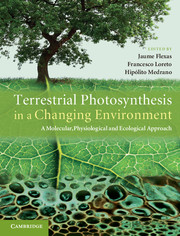 Terrestrial Photosynthesis in a Changing Environment
Terrestrial Photosynthesis in a Changing Environment Book contents
- Frontmatter
- Contents
- List of contributors
- Preface
- Acknowledgements
- List of abbreviations
- 1 Terrestrial photosynthesis in a changing environment
- Part I Photosynthesis
- Part II Measuring photosynthesis
- Part III Photosynthetic response to single environmental factors
- Part IV Photosynthesis in time
- 23 Photosynthesis during leaf development and ageing
- 24 Evolution of photosynthesis I: basic leaf morphological traits and diffusion and photosynthetic structures
- 25 Evolution of photosynthesis II: evolution and expansion of CAM and C4 photosynthetic types
- Part V Photosynthesis in space
- Part VI Photosynthesis in a global context
- References
- Index
23 - Photosynthesis during leaf development and ageing
Published online by Cambridge University Press: 05 March 2013
- Frontmatter
- Contents
- List of contributors
- Preface
- Acknowledgements
- List of abbreviations
- 1 Terrestrial photosynthesis in a changing environment
- Part I Photosynthesis
- Part II Measuring photosynthesis
- Part III Photosynthetic response to single environmental factors
- Part IV Photosynthesis in time
- 23 Photosynthesis during leaf development and ageing
- 24 Evolution of photosynthesis I: basic leaf morphological traits and diffusion and photosynthetic structures
- 25 Evolution of photosynthesis II: evolution and expansion of CAM and C4 photosynthetic types
- Part V Photosynthesis in space
- Part VI Photosynthesis in a global context
- References
- Index
Summary
Introduction
Periods of leaf development and senescence comprise a significant fraction of leaf lifespan. Therefore, leaf lifetime carbon gain is importantly modified by the overall duration and time kinetics of these processes (Wilson et al., 2001; Morecroft et al., 2003; Grassi and Magnani, 2005). In addition, significant time-dependent changes occur in leaf function in mature non-senescent leaves owing to continuous accumulation of cell walls and concomitant reductions in mesophyll-diffusion conductance, as well as owing to re-acclimation of foliage to dynamically changing environmental conditions. Such modifications are of particular importance in evergreen species supporting foliage for several growing seasons, but foliage structure and physiological potentials also change in mature non-senescent leaves in deciduous species (Flexas et al., 2001; Wilson et al., 2001; Niinemets et al., 2004a).
A large body of information of fine-scale regulation of leaf development and senescence has become available (Dengler and Kang, 2001; Kessler and Sinha, 2004; Fleming, 2005; Lim et al., 2007). Although these studies cover in depth the regulatory sequences and signalling pathways during leaf development and senescence, the last comprehensive series of reviews on leaf photosynthetic modifications in developing leaves was published in 1985 (Shesták, 1985). Furthermore, the available treatises of leaf ontogenetic effects on photosynthesis have focused on herbaceous plants or on fast-growing deciduous trees. However, the rate of developmental and ageing processes largely differs among species with varying leaf longevity and structure (Miyazawa et al., 2003). Consideration of these functional-type specific variation patterns in leaf development is of major importance for prediction of plant photosynthetic productivity of highly structured natural plant communities consisting of species with varying leaf longevity and architectural constitution.
- Type
- Chapter
- Information
- Terrestrial Photosynthesis in a Changing EnvironmentA Molecular, Physiological, and Ecological Approach, pp. 353 - 372Publisher: Cambridge University PressPrint publication year: 2012
- 28
- Cited by


